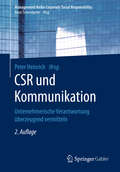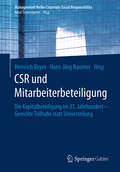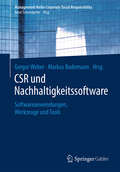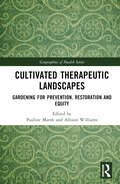- Table View
- List View
CSR und Geschäftsmodelle: Auf dem Weg zum zeitgemäßen Wirtschaften (Management-Reihe Corporate Social Responsibility)
by Patrick BungardDieses Buch beschreibt, wie soziale, ökologische und wirtschaftliche Aspekte mittels innovativer Geschäftsmodelle gewinnbringend miteinander in Einklang gebracht werden können. Anhand zahlreicher Praxisbeispiele und Fachbeiträge zeigen Autoren aus Wissenschaft und Praxis wie Unternehmen in gleichem Maße Mehrwert für die eigene Organisation und die Gesellschaft schaffen. Aufgrund der globalen Herausforderungen des 21. Jahrhunderts stehen Unternehmen vor der Konfrontation mit sich rasant verändernden wirtschaftlichen Rahmenbedingungen. Der Klimawandel, das Bevölkerungswachstum oder der demographische Wandel sind nur einige Themen auf die sich Unternehmen einstellen müssen. Zum einen um konkurrenzfähig zu bleiben, zum anderen um Ihre gesellschaftliche Verantwortung wahrzunehmen. Dieses Buch zeigt, dass gesellschaftlicher Nutzen und unternehmerisches Eigeninteresse nicht im Widerspruch zueinander stehen sondern ihre Verschmelzung im Rahmen von Geschäftsmodellen vielseitige Chancen und Möglichkeiten bietet.
CSR und Hidden Champions: Mit Unternehmensverantwortung zum Weltmarktführer (Management-Reihe Corporate Social Responsibility)
by Sascha Genders Christian SeynstahlDieses Buch wirft einen Blick auf den deutschen Mittelstand, insbesondere auf Hidden Champions. Erfolgreiche, nicht selten familiengeführte Unternehmen leisten einen wichtigen Beitrag für den Wirtschaftsstandort Deutschland, sie sind zudem wesentliche Akteure im Sinne des ehrbaren Unternehmertums und der Verantwortungsübernahme durch die Wirtschaft. Hidden Champions tragen maßgeblich zu Innovationskraft, Resilienz und Zukunftsfähigkeit von Wirtschaftsregionen bei. Und nicht zuletzt in der öffentlichen Wahrnehmung als Träger von CSR wächst deren Relevanz zusehends. Das Buch liefert durch Fachbeiträge sowie insbesondere durch das Aufzeigen von Best-Practice-Beispielen erfolgreicher Hidden Champions einen wichtigen Beitrag in der Diskussion, warum gerade diese Unternehmen zu den internationalen Spitzenleistern gehören. Der Wahrnehmung von CSR in all ihren Facetten kommt hierbei ein besonderer Stellenwert zu, den es lohnt, näher zu betrachten.
CSR und Hochschulmanagement: Sustainable Education als neues Paradigma in Forschung und Lehre (Management-Reihe Corporate Social Responsibility)
by Monika Kolb Markus RaueiserOb es um die Einführung neuer Verwaltungsstrukturen, die Diversität von Studierenden und Lehrenden, die Demokratisierung von Wissen oder die demografische Entwicklung geht – Hochschulen befinden sich beständig im Wandel. Was bedeutet Hochschulentwicklung vor diesem Hintergrund und wie lassen sich die aktuellen Herausforderungen für das Hochschulmanagement nutzen? In dem Buch diskutieren Hochschulangehörige aus verschiedenen Fakultäten und aus der Verwaltung, aber auch Studierende sowie Akteure aus Politik, Forschung und Wirtschaft, inwieweit Corporate Social Responsibilty (CSR) und Sustainable Education geeignete Konzepte für den Umgang mit diesen inneren und äußeren Veränderungen sind.Anhand von Praxisbeispielen aus namhaften privaten wie öffentlichen Hochschulen reflektieren die Autoren ihre Erfahrungen und Erkenntnisse als Stakeholder in und im Umfeld von Hochschulen. Können Hochschulen die Herausforderungen nutzen, um neue, passendere Organisationsstrukturen zu entwerfen und die Institution Hochschule weiterzuentwickeln? Wie verläuft der Weg vom kritischen Hinterfragen der Prozesse und Strukturen innerhalb der Hochschulorganisation hin zu einem besseren, nachhaltigen Hochschulmanagement und was können die verschiedenen Akteure dazu beitragen?Die Buchbeiträge liefern nicht nur Handlungsempfehlungen für das Hochschulmanagement, sondern regen auch zur Auseinandersetzung mit den Konzepten von Corporate Social Responsibilty (CSR) und Nachhaltigkeit im Kontext der Organisationsentwicklung in der Hochschule an. Damit bietet der Band auch einen Überblick zum aktuellen Stand der Diskussion – für Wissenschaftler, für Praktiker und für Experten in und außerhalb der Hochschule.
CSR und Inklusion: Bessere Unternehmensperformance durch gelebte Teilhabe und Wirksamkeit (Management-Reihe Corporate Social Responsibility)
by Andrea Sihn-WeberErfahren Sie in diesem Buch wie gelebte Inklusion zu einer besseren Unternehmensperformance beiträgt!Ziel dieses Buches ist es, Führungskräften sowie im speziellen Diversitätsbeauftragten, CSR- und HR-Verantwortlichen und allen an dieser Thematik Interessierten einen praxisnahen – auf aktuellen wissenschaftlichen Erkenntnissen beruhenden – Einblick zu geben, wie Diversität und Inklusion in Organisationen bestmöglich gelebt werden kann. Es wird beleuchtet, wie unterschiedliche Menschen so zusammen arbeiten können, dass ihre Stärken optimal genutzt werden und sie einen hohen Grad an Selbstwirksamkeit erleben. Zudem wird herausgearbeitet, was „Inclusive Leadership“ bedeutet, und wie dieser Ansatz zu einer besseren Performance in Unternehmen beitragen kann. Ebenso werden Zukunftstrends und neueste gesetzliche Anforderungen analysiert, aber auch die Rolle der Diversitätsperspektive im Umgang mit der Corona-Pandemie. Social Enterprises erläutern, wie sie Diversität und Inklusion in der Gesellschaft durch innovative und nachhaltige Geschäftsmodelle fördern. Vor dem Hintergrund der UN Sustainable Development Goals werden Best-Practice-Beispiele aus Unternehmen unterschiedlicher Branchen – wie etwa der Pharma- oder Finanzindustrie – sowie dem Bildungsbereich vorgestellt. Abschließend wird aufgezeigt, wie mehr Diversität und Inklusion maßgeblich zu einer nachhaltigeren Zukunft beitragen, in der Kooperation, Innovation, Engagement und Empowerment von zunehmender strategischer Bedeutung sind. Folgende Themenschwerpunkte geben praxisorientierten Einblick wie Diversität erfolgreich umgesetzt werden kann:Einführung in die Diversitäts- und InklusionsthematikEmpfehlungen der Wissenschaft sowie DiversitätsberatungGeschäftsmodelle von Social Enterprises zur Förderung von InklusionBest-Practice-Beispiele aus der Wirtschaft und dem BildungsbereichAktivitäten von Interessensvertretungen, Verbänden, Vereinen und NGOs
CSR und Institutionen: Etablierung unternehmerischer Verantwortung in Wirtschaft, Politik und Gesellschaft (Management-Reihe Corporate Social Responsibility)
by Sascha GendersWerfen Sie einen detaillierten Blick in die Praxis von CSR ausgewählter Institutionen aus den Bereichen Wirtschaft, Politik, Forschung und Zivilgesellschaft Dieses Buch zeigt, welche Rolle Corporate Social Responsibility aus Sicht dieser Akteure spielt. Neben der Beantwortung der Frage nach der eigenen Auseinandersetzung innerhalb der Institution, wird insbesondere verdeutlicht, welche Ansätze zur gesamtgesellschaftlichen Diskussion rund um CSR verfolgt werden. Es wird praxisnah die konzeptionelle, strategische Auseinandersetzung mit Unternehmensverantwortung dargestellt und zugleich vergegenwärtigt, mit welchen konkreten Maßnahmen und Ansatzpunkten - zum Beispiel mit dem Fokus Interessenvertretung oder Dienstleistungen - bei den relevanten Zielgruppen - Unternehmen, Mitgliedern oder interessierter Öffentlichkeit - für die Wahrnehmung von CSR geworben und für dessen Relevanz sensibilisiert wird. Hier gelingt ein erster Versuch den Nexus zwischen der gesellschaftlichen Verantwortung von Unternehmen, den institutionellen Strukturen sowie den globalen Rahmenbedingungen aufzuzeigenIn Anbetracht der zahlreichen Wechselwirkungen zwischen Unternehmen und ihren jeweiligen Standorten, erscheint es nur logisch und konsequent, die Potenziale, Motive, Strategien und Projekte von Unternehmen als „Partner der Gesellschaft“ in Rahmen der Weiterentwicklung gesellschaftlicher Institutionen zu sehen. Denn gesellschaftliche Institutionen können in Sachen Nachhaltigkeit nur so gut sein, wie es die Unternehmen sind. Und umgekehrt gilt, dass Unternehmen nur dann nachhaltige Geschäftsmodelle erfolgreich umsetzen können, wenn die dazu notwendigen institutionellen Rahmenbedingungen vorhanden sind. Die vorliegende Publikation verdeutlicht, dass neue Kooperationen zwischen Wirtschaft, Politik und Zivilgesellschaft zur Förderung Nachhaltigen Unternehmertum die deutsche Institutionenlandschaft konstruktiv verändern wird. Das Buch stellt damit die dringend benötigte Brücke zwischen dem Forschungs- und Handlungsfeldern der gesellschaftlichen, politischen und wirtschaftlichen CSR-Diskussion da.
CSR und Interkulturelles Management: Gesellschaftliche und unternehmerische Verantwortung international bewältigen (Management-Reihe Corporate Social Responsibility)
by Anja B. Karlshaus Ingvill C. MochmannDieser Band beleuchtet die interkulturellen Herausforderungen, die bei der Umsetzung von CSR-Strategien auftreten können. In den letzten Jahren ist eine nachhaltige Implementation von CSR immer mehr in den Fokus global agierender Unternehmen gerückt. Dabei konnten jedoch oftmals nur bestimmte CSR-Aspekte in einzelnen Funktionsbereichen der Unternehmen verankert werden, da viele verschiedene Hierarchieebenen und Abteilungen entlang der Value Chain in einen derartigen Entscheidungsprozess involviert sind. Ein weiteres Hindernis auf dem Weg zu einer ganzheitlichen CSR-Strategie auf allen Unternehmensebenen besteht in der Kulturabhängigkeit von Corporate Social Responsibilty, die sich in uneinheitlichen Definitionen und unterschiedliche Umsetzungsaktivitäten zeigt. Die sich daraus ergebenden Frage- und Problemstellungen werden in diesem Buch anhand von Fallbeispielen verschiedener Ländern illustriert, die unternehmerische Verantwortung und Compliance sehr unterschiedlich umgesetzt haben. Gemein ist ihnen dabei jedoch die Schwerpunktsetzung auf Themen wie die internationale Wertevermittlung und die CSR-Verankerung im Personalmanagement. Daneben stehen auch Corporate Volunteering-Programme, das Flüchtlingsengagement sowie eine nachhaltige interkulturelle Zusammenarbeit entlang der Wertschöpfungskette häufig im Vordergrund der Tätigkeiten vieler Unternehmen. Ob als Führungskraft in der Wirtschaft oder Berater aus der Forschung, in diesem Buch finden Sie zahlreiche Konzepte und Instrumente zur Einbindung interkultureller Aspekte in die CSR-Strategie eines Unternehmens. Werden Sie jetzt aktiv und nutzen Sie die Erkenntnisse aus den vorgestellten Best Cases, um den Shareholder Value Ihres Unternehmens zu erhöhen.
CSR und Klimawandel: Unternehmenspotenziale und Chancen einer nachhaltigen und klimaschonenden Wirtschaftstransformation (Management-Reihe Corporate Social Responsibility)
by Andrea Sihn-Weber Franz FischlerWie begegnen Unternehmen dem Klimawandel? Dieses Buch zeigt es Ihnen!Dieses Buch gibt Ihnen einen Einblick, wie Sie in der wirtschaftlichen Praxis dem Klimawandel entgegenwirken und erfolgreich mit seinen direkten und indirekten Folgen umgehen. Die Autoren untersuchen die klimawandelinduzierten Risiken und ihre Steuerung aus betriebswirtschaftlicher Sicht. Weiter arbeiten sie heraus, welche Unternehmenspotenziale und Chancen durch eine nachhaltige und klimaschonende Wirtschaftstransformation entstehen können. Auf diese Weise zeigen Ihnen die Herausgeber, wie aus einem der größten Probleme unserer Zeit auch wirtschaftliche Erfolgsmodelle entstehen können. Die einzelnen Fachbeiträge renommierter Autorinnen und Autoren stellen zudem aktuelle Erkenntnisse der Wissenschaft, Pläne der Politik sowie Forderungen von Interessensvertretungen und NGOs vor. Konkrete Best Practice-Beispiele unterschiedlichster Branchen runden den Inhalt ab. Gleichzeitig prüft dieses Werk Klimaziele und Maßnahmen internationaler Initiativen und Entwicklungen, wie beispielsweise das Pariser Klimaabkommen. Dadurch fordert dieses Buch mit Blick auf den Klimawandel Unternehmen im Zuge ihrer ökologischen sowie gesellschaftlichen Verantwortung zum Handeln auf. Innovative Impulse für UnternehmenDieses Buch liefert Ihnen aktuelle Erkenntnisse aus der Wissenschaft zum Klimawandel. Die Autoren erörtern, welche Auswirkungen die Klimakrise auf Wirtschaft und Gesellschaft hat und welche Rolle der Digitalisierung im Kontext von Nachhaltigkeit und Klimaänderung zukommt. Anschließend rücken die folgenden Kapitel unter anderem diese Aspekte in den Mittelpunkt: Internationale, europäische und nationale KlimapolitikDigitalisierung und Klimawandel im Kontext der Sustainable Development GoalsKlimaschonende Veredelung regenerativer RohstoffeVersorgungssicherheit in Zeiten des KlimawandelsIntegration von CSR und Klimaschutz in das Kerngeschäft der Österreichischen Post AGDekarbonisierungsstrategien für Aktieninvestitionen Auf diese Weise liefert dieses Buch Unternehmen zahlreiche Impulse, um im Zuge des Klimawandels innovative Strategien und Anpassungsmöglichkeiten zu entwickeln. So lassen sich bisher unerschlossene wirtschaftliche Potenziale nutzen.
CSR und Kommunikation: Unternehmerische Verantwortung überzeugend vermitteln (Management-Reihe Corporate Social Responsibility)
by Peter HeinrichDiese aktualisierte und überarbeitete 2. Auflage liefert einen fundierten, praxisbezogenen Überblick über die Kommunikationsinstrumente und -möglichkeiten sowie den Planungsprozess im Bereich CSR. Es ist ein Ideenkatalog und vermittelt zugleich auch das wissenschaftliche Hintergrundwissen. 20 Praxisbeiträge aus verschiedenen Branchen zeigen, wie die CSR-Kommunikation wirksam angewendet wird. Viele Unternehmen engagieren sich heute gesellschaftlich und übernehmen Verantwortung. Ein sinnvoller Schritt, denn so leisten sie einen Beitrag zur gesamtwirtschaftlichen Nachhaltigkeit, prägen ihr Image und generieren dabei gezielt Wettbewerbsvorteile. Ein wichtiger Schlüssel zum Erfolg liegt dabei in der Kommunikation. „Tue Gutes und sprich darüber“ – es geht um die Kommunikation mit allen relevanten Dialoggruppen. In diesem Zusammenhang gibt dieses Buch den Menschen, die sich mit CSR beschäftigen – ob auf Unternehmens- oder Beraterseite, ob als Newcomer oder als Experte – Orientierung, Impulse und Handlungsempfehlungen für die tägliche Praxis.
CSR und Künstliche Intelligenz (Management-Reihe Corporate Social Responsibility)
by Reinhard Altenburger René SchmidpeterIn diesem Buch werden neben Impulsen aus der aktuellen wissenschaftlichen Diskussion Good Practice Cases von Unternehmen im Umgang mit den besonderen Herausforderungen durch den Einsatz von Künstlicher Intelligenz (KI) vorgestellt.Die vielfältigen Herangehensweisen an die Anforderungen, welche mit dem Einsatz von Künstlicher Intelligenz verbunden sind, sollen Anregungen für Unternehmen und Wissenschaft in diesem häufig sehr kontrovers diskutierten Feld bieten. Ein besonderes Gewicht wird auf die Chancen durch KI für Unternehmen aus unterschiedlichen Branchen gelegt. Die Auseinandersetzung mit dem Spannungsfeld KI und neue Herausforderungen der CSR bietet strategische Möglichkeiten, aber auch Innovationschancen. Die aktive Einbindung von Stakeholdern in den Gestaltungsprozess dient auch dem Aufbau von Vertrauen bei Kunden und der Öffentlichkeit und leistet somit einen Beitrag zu Innovation und Akzeptanz von KI.Der Beitrag Künstliche Intelligenz & die Zukunft von Arbeit wird unter der Creative Commons Namensnennung 4.0 International Lizenz veröffentlicht.
CSR und Mitarbeiterbeteiligung: Die Kapitalbeteiligung Im 21. Jahrhundert - Gerechte Teilhabe Statt Umverteilung (Management-Reihe Corporate Social Responsibility)
by Heinrich Beyer Hans-Jörg Naumer„Die Armen werden immer ärmer, die Reichen immer reicher“ – das ist wohl die Kurzformel einer der drängendsten Debatten unserer Zeit. Dabei kennt diese Debatte scheinbar nur eine Antwort: Umverteilung. Mit „Gerechte Teilhabe statt Umverteilung“ gehen die Autoren dieses Buches programmatisch bewusst einen anderen Weg: Sie wollen Teilhabe durch Kapitalbeteiligung.Ihr gesamtwirtschaftlicher und gesellschaftlicher Blick auf die Mitarbeiterbeteiligung als Form gerechter Teilhabe führt daher zu einem radikalen neuen Ansatz zu den Themen „Kapital“ und „Arbeit“. 150 Jahre nach Erscheinen von „Das Kapital“ - Karl Marx, drei Jahre nach Erscheinen von „Das Kapital im 21. Jahrhundert“ -Thomas Piketty, aber auch beinahe 75 Jahre nach der „Freiburger Denkschrift“ - Walter Eucken et al., die konstitutiv für unsere Wirtschaftsordnung ist, gehen die Autoren daran, die Brücke zwischen Kapital und Arbeit zu schlagen, und rollen damit die Debatte um Arm und Reich lösungsorientiert neu auf.Vermögensbildung durch Kapitalbeteiligung stellt den zentralen Inhalt des Buches dar. Einen Schwerpunkt dabei bildet die Motivation, Kapitalbeteiligung als Antwort auf den technologischen Wandel in der Wirtschaft zu gestalten. Dafür wird auch das „Bedingungslose Grundeinkommen für die Industrie 4.0“ aus einer völlig neuen Perspektive diskutiert und „Teilhaberfonds“ als Möglichkeit, Eigentumsrechte mit risikomindernder Diversifikation zu verbinden, in die Diskussion eingeführt. Das Buch ist dabei auch ein Anwenderbuch: Es führt keine Diskussion im Elfenbeinturm, sondern unterbreitet Vorschläge sowohl für die betriebliche als auch die politische Praxis. Fundiert, aber dennoch leicht lesbar, wendet es sich an eine gesellschaftspolitisch interessierte Zielgruppe in Politik, Wirtschaft und Unternehmen.
CSR und Nachhaltigkeitssoftware: Softwareanwendungen, Werkzeuge und Tools (Management-Reihe Corporate Social Responsibility)
by Gregor Weber Markus BodemannUnternehmen müssen heute Antworten auf ökonomische, soziale und ökologische Herausforderungen finden, wenn sie langfristig Erfolg haben wollen. Aber wie lässt sich Corporate Social Responsibility (CSR) nach dem Grundsatz „mehr Ökonomie durch Ökologie“ managen? Welche Hilfsmittel stehen Unternehmen und Organisationen dafür zur Verfügung? Das Buch konzentriert sich auf Software, Instrumente und Tools für das Nachhaltigkeitsmanagement und schließt damit eine wichtige Lücke.Im ersten Teil zeigen die Autoren, welche Bedeutung Nachhaltigkeit, Nachhaltigkeitsmanagement und Nachhaltigkeitsberichterstattung für Unternehmen und Organisationen haben und was die am Markt gängigen Softwaretools bieten. Hier kommen nicht nur Wissenschaftler zu Wort, sondern auch Vertreter politischer Organisationen wie der Vereinten Nationen oder des Rates für Nachhaltige Entwicklung der Bundesregierung. Im mittleren Teil stellen führende Anbieter von Software für Nachhaltigkeitsmanagement ihre Anwendungen vor. Dabei liefern sie nicht nur einen Überblick über die Funktionalitäten, sondern beschreiben auch Zusatzbausteine und Synergieeffekte, die sich aus der Kombination mit anderen Systemen ergeben. Screenshots helfen Lesern, einen Einblick in Aufbau und Struktur der Software zu gewinnen. Berichte von Anwendern aus Unternehmen und Organisation runden den Überblick über die Tools ab.Das Buch richtet sich an Verantwortliche in Unternehmen und Organisationen, die wissen wollen, wie Nachhaltigkeitsmanagement effektiv betrieben werden kann.
CSR und Social Enterprise: Beeinflussungsprozesse und effektives Schnittstellenmanagement (Management-Reihe Corporate Social Responsibility)
by Alexander Kraemer Laura Marie Edinger-SchonsLernen Sie in diesem Buch mehr über einen besonderen Zugang zu Corporate Social Responsibility: Das Social EnterpriseIn diesem Band „CSR und Social Enterprise - Beeinflussungsprozesse und effektives Schnittstellenmanagement“ stellen die Herausgeber Alexander Kraemer und Laura Marie Edinger-Schons fundiert und praxisnah einen besonderen Zugang zu Corporate Social Responsibility (CSR) vor: Das Social Enterprise. In der heutigen Zeit stellt die Gesellschaft viele neue Anforderungen an Unternehmen. Jeder Betrieb reagiert unterschiedlich auf die geänderten Voraussetzungen. Immer mehr von ihnen richten eigene CSR-Abteilungen ein, die eher soziale als profitorientierte Zielsetzungen verfolgen. Weiterhin kooperieren sie stärker mit sogenannten Social Enterprises. Hierunter versteht man sich selbst finanzierende Geschäftsmodelle mit folgenden Zielsetzungen:a) Lösung sozialer oder ökologischer Problemeb) Gründen von Stiftungen mit sozialer ZielsetzungAußerdem werden in diesem Corporate-Social Responsibility-Buch erstmalig Unternehmensverantwortung und Sozialunternehmertum miteinander in Verbindung gebracht.Anschauliche Ansätze sowie Strategien aus Wissenschaft und PraxisZahlreiche Autoren beleuchten aus der Perspektive von Wissenschaft und Praxis anschaulich, wie in diesen Kooperationen gegenseitige Beeinflussungsprozesse stattfinden. Denn dadurch verändert sich nicht selten die traditionelle Art zu wirtschaften hin zu mehr Nachhaltigkeit. Damit diese Prozesse aber auch zu einer positiven Veränderung führen, müssen Schnittstellen effektiv gestaltet und Kulturunterschiede überwunden werden. Deshalb geht es in diesem Corporate-Social Responsibility-Buch um folgende Inhalte:Teil I - Grundlagen zur Schnittstelle: CSR und Social EnterpriseTeil II - Effektives SchnittstellenelementTeil III - Best Practice Case StudiesTeil IV - AusblickAlexander Kraemer und Laura-Marie Edinger-Schons sind davon überzeugt, dass die Zusammenarbeit zwischen den verschiedenen Akteuren im Social Business entscheidende Beiträge zur Lösung konkreter sozialer und ökologischer Herausforderungen leisten kann. Mit diesem Band möchten sie einen Beitrag zur aktuellen Diskussion um diese Themen und Fragestellungen leisten.
CT Scanning of Carbonate Reservoirs: A Color Atlas
by Vahid TavakoliThe Computed Tomography (CT) scanning of carbonate reservoirs is a non-destructive method used to obtain valuable information from reservoir rocks. This concise book covers all aspects of CT image analysis and their interpretation. It is focused on the CT scanned images and the data gathered from various carbonate reservoirs with different ages, from Paleozoic to Tertiary, and with different textures, degrees of heterogeneity, facies types, diagenetic impacts, fossil contents, sedimentary structures, reservoir quality, and fracturing. Numerous high-resolution images illustrate various aspects of carbonate rock properties and are suitable for analysis by both professionals and students. FEATURES Provides the first specialized book about core CT scanned image descriptions and explanations Contains supplementary data from various sources, such as image logs, cores, and thin section photos and petrophysical measurements Includes original CT images from different reservoirs Covers both research and industrial aspects of core CT scanning and is useful for comparing CT scanned images Uses original images and reservoir data gathered by the author This book can be used by professionals working in the oil and gas industry, researchers and academics studying petroleum-related disciplines, and students taking courses in petroleum geology and reservoir engineering. It can also be used in a range of related sciences, such as sedimentology, soil sciences, paleontology, petrology, engineering geology, study of porous materials, and hydrogeology.
CT Scanning of Carbonate Reservoirs: A Color Atlas
by Vahid TavakoliThe Computed Tomography (CT) scanning of carbonate reservoirs is a non-destructive method used to obtain valuable information from reservoir rocks. This concise book covers all aspects of CT image analysis and their interpretation. It is focused on the CT scanned images and the data gathered from various carbonate reservoirs with different ages, from Paleozoic to Tertiary, and with different textures, degrees of heterogeneity, facies types, diagenetic impacts, fossil contents, sedimentary structures, reservoir quality, and fracturing. Numerous high-resolution images illustrate various aspects of carbonate rock properties and are suitable for analysis by both professionals and students. FEATURES Provides the first specialized book about core CT scanned image descriptions and explanations Contains supplementary data from various sources, such as image logs, cores, and thin section photos and petrophysical measurements Includes original CT images from different reservoirs Covers both research and industrial aspects of core CT scanning and is useful for comparing CT scanned images Uses original images and reservoir data gathered by the author This book can be used by professionals working in the oil and gas industry, researchers and academics studying petroleum-related disciplines, and students taking courses in petroleum geology and reservoir engineering. It can also be used in a range of related sciences, such as sedimentology, soil sciences, paleontology, petrology, engineering geology, study of porous materials, and hydrogeology.
A Cubic Mile of Oil: Realities and Options for Averting the Looming Global Energy Crisis
by Hewitt Crane Edwin Kinderman Ripudaman MalhotraOne cubic mile of oil (CMO) corresponds very closely to the world's current total annual consumption of crude oil. The world's total annual energy consumption - from all energy sources- is currently 3.0 CMO. By the middle of this century the world will need between 6 and 9 CMO of energy per year to provide for its citizens. Adequate energy is needed remove the scourge of poverty and provide food, clothing, and shelter for the people around the world, and more will be needed for measures to mitigate the potential effects of climate change such as building dikes and desalinating water. A Cubic Mile of Oil describes the various energy sources and how we use them, projects their future contributions, and delineates what it would take to develop them to annually produce a CMO from each of them. The requirement for additional energy in the future is so daunting that we will need to use all resources. We also examine how improved efficiency and conservation measures can reduce future demand substantially, and help distinguish approaches that make a significant impact as opposed to merely making us feel good. Use of CMO eliminates a multitude of units like tons of coal, gallons of oil, and cubic feet of gas; obviates the need for mind-numbing multipliers such as billions, trillions, and quadrillions; and replaces them with an easy-to-understand volumetric unit. It evokes a visceral response and allows experts, policy makers and the general public alike to form a mental picture of the magnitude of the challenge we face. In the absence of an appreciation of the scale of the problem, we risk squandering efforts and resources in pursuing options that will not meet tomorrow's global energy needs. We must make critical choices, and a common understandable language is essential for a sustained meaningful dialog.
A Cubic Mile of Oil: Realities and Options for Averting the Looming Global Energy Crisis
by Ripudaman Malhotra Hewitt Crane Edwin KindermanOne cubic mile of oil (CMO) corresponds very closely to the world's current total annual consumption of crude oil. The world's total annual energy consumption - from all energy sources- is currently 3.0 CMO. By the middle of this century the world will need between 6 and 9 CMO of energy per year to provide for its citizens. Adequate energy is needed remove the scourge of poverty and provide food, clothing, and shelter for the people around the world, and more will be needed for measures to mitigate the potential effects of climate change such as building dikes and desalinating water. A Cubic Mile of Oil describes the various energy sources and how we use them, projects their future contributions, and delineates what it would take to develop them to annually produce a CMO from each of them. The requirement for additional energy in the future is so daunting that we will need to use all resources. We also examine how improved efficiency and conservation measures can reduce future demand substantially, and help distinguish approaches that make a significant impact as opposed to merely making us feel good. Use of CMO eliminates a multitude of units like tons of coal, gallons of oil, and cubic feet of gas; obviates the need for mind-numbing multipliers such as billions, trillions, and quadrillions; and replaces them with an easy-to-understand volumetric unit. It evokes a visceral response and allows experts, policy makers and the general public alike to form a mental picture of the magnitude of the challenge we face. In the absence of an appreciation of the scale of the problem, we risk squandering efforts and resources in pursuing options that will not meet tomorrow's global energy needs. We must make critical choices, and a common understandable language is essential for a sustained meaningful dialog.
Culinary Man and the Kitchen Brigade: Normative Subjectivity in Western Fine Dining Traditions (Routledge Food Studies)
by Jordan FallonCulinary Man and the Kitchen Brigade offers an exploration of the field of normative subjectivity circulated within western fine dining traditions, presenting a theoretical analysis of the governing relationship between the chef, who embodies the Culinary Man, and the fine dining brigade.The book offers a unique treatment of western haute cuisine’s interlocking regime of labor and aesthetics and theorizes the underexplored kitchen brigade as a model of disciplinary formation. It deploys a heterogeneous set of disciplinary discourses and practices which have the effect of consolidating monopolies on epistemic authority and governance. Each position within the brigade’s hierarchy is subject to distinct, though related, disciplinary practices. Thus, chapters identify the specific practices pertinent to each brigade subject, while also illuminating how they fit together as a coherent hegemonic project. The application of Wynterian and Foucauldian insight to the fine dining brigade offers a political theory of culinary work which departs from other food studies texts. Notably, this work offers an in-depth treatment of the brigade’s colonial dimensions which resonate with emerging critiques, scholarly and general, of the race and gender politics of restaurant labor. The concluding chapters seek to identify where extant modes of resistance or alternative forms of culinary organization may hold the potential to move beyond the hegemonic overrepresentation of Culinary Man.This book will be of great interest to students and scholars from across the social sciences and humanities interested in critical food studies, political and cultural theory, and popular culinary culture.
Culinary Man and the Kitchen Brigade: Normative Subjectivity in Western Fine Dining Traditions (Routledge Food Studies)
by Jordan FallonCulinary Man and the Kitchen Brigade offers an exploration of the field of normative subjectivity circulated within western fine dining traditions, presenting a theoretical analysis of the governing relationship between the chef, who embodies the Culinary Man, and the fine dining brigade.The book offers a unique treatment of western haute cuisine’s interlocking regime of labor and aesthetics and theorizes the underexplored kitchen brigade as a model of disciplinary formation. It deploys a heterogeneous set of disciplinary discourses and practices which have the effect of consolidating monopolies on epistemic authority and governance. Each position within the brigade’s hierarchy is subject to distinct, though related, disciplinary practices. Thus, chapters identify the specific practices pertinent to each brigade subject, while also illuminating how they fit together as a coherent hegemonic project. The application of Wynterian and Foucauldian insight to the fine dining brigade offers a political theory of culinary work which departs from other food studies texts. Notably, this work offers an in-depth treatment of the brigade’s colonial dimensions which resonate with emerging critiques, scholarly and general, of the race and gender politics of restaurant labor. The concluding chapters seek to identify where extant modes of resistance or alternative forms of culinary organization may hold the potential to move beyond the hegemonic overrepresentation of Culinary Man.This book will be of great interest to students and scholars from across the social sciences and humanities interested in critical food studies, political and cultural theory, and popular culinary culture.
Cull of the Wild: Killing in the Name of Conservation
by Hugh WarwickInvestigating the ethical and practical challenges of one of the greatest threats to biodiversity: invasive species.Across the world, invasive species pose a danger to ecosystems. The UN Convention on Biological Diversity ranks them as a major threat to biodiversity on par with habitat loss, climate change and pollution.Tackling this isn't easy, and no one knows this better than Hugh Warwick, a conservationist who loathes the idea of killing, harming or even eating animals. Yet as an ecologist, he is acutely aware of the need, at times, to kill invasive species whose presence harms the wider environment.Hugh explores the complex history of species control, revealing the global movement of species and the impacts of their presence. Combining scientific theory with gentle humour in his signature style, he explains the issues conservationists face to control non-native animals and protect native species – including grey and red squirrels on Anglesey, ravens and tortoises in the Mojave Desert, cane toads in Australia and the smooth-billed ani on the Galapagos – and describes cases like Pablo Escobar's cocaine hippos and the Burmese python pet trade.Taking a balanced and open approach to this emotive subject, Hugh speaks to experts on all sides of the debate. How do we protect endangered native species? Which species do we prioritise? And how do we reckon with the ethics of killing anything in the name of conservation?
Cull of the Wild: Killing in the Name of Conservation
by Hugh WarwickInvestigating the ethical and practical challenges of one of the greatest threats to biodiversity: invasive species.Across the world, invasive species pose a danger to ecosystems. The UN Convention on Biological Diversity ranks them as a major threat to biodiversity on par with habitat loss, climate change and pollution.Tackling this isn't easy, and no one knows this better than Hugh Warwick, a conservationist who loathes the idea of killing, harming or even eating animals. Yet as an ecologist, he is acutely aware of the need, at times, to kill invasive species whose presence harms the wider environment.Hugh explores the complex history of species control, revealing the global movement of species and the impacts of their presence. Combining scientific theory with gentle humour in his signature style, he explains the issues conservationists face to control non-native animals and protect native species – including grey and red squirrels on Anglesey, ravens and tortoises in the Mojave Desert, cane toads in Australia and the smooth-billed ani on the Galapagos – and describes cases like Pablo Escobar's cocaine hippos and the Burmese python pet trade.Taking a balanced and open approach to this emotive subject, Hugh speaks to experts on all sides of the debate. How do we protect endangered native species? Which species do we prioritise? And how do we reckon with the ethics of killing anything in the name of conservation?
Cultivated Therapeutic Landscapes: Gardening for Prevention, Restoration, and Equity (Geographies of Health Series)
by Pauline Marsh Allison WilliamsCultivated Therapeutic Landscapes provides an in-depth and critical explora-tion of the impact of gardens and gardening on health and wellbeing. In this book we explore the ways in which gardens and gardening prevent illness and restore wellbeing, and how they improve social and health equity via tradi-tional and innovative mechanisms and across a range of sites. Therapeutic landscapes are relational, reciprocal, and evolving. In this book, leading scholars from across the globe demonstrate how therapeutic landscapes research and practice is expanded through and around the pro-cesses of cultivation. Deliberately interdisciplinary, the book explores how tending and caring for green spaces, collectively and individually, works to pre-vent and restore health and wellbeing, as well as impact upstream factors de-termining social justice and equity. A unique combination of academics, clinicians, and practitioners deliver theoretical and practical insights into wide-ranging health-enabling factors, based on new evidence and autoethno-graphic experiences in home gardens, school, and community gardens, clinical settings, public green spaces, and sites of conservation and wildness. This book pushes concepts of cultivation and horticulture into underexplored spatial, on-tological, and wellbeing territories. Despite long-term practical interest, thera-peutic horticulture is only now establishing a strong theoretical and research foundation. This book provides much-needed critical insights into the impact on the key drivers of health, wellbeing, and social equity, with a focus on practical skills for utilising horticulture or designing for particular health needs. It will be of interest to students, scholars, and practitioners in the areas of health geogra-phy; cultural geography; cultural studies; therapeutic horticulture; environ-mental studies; community development and planning; landscape architecture; social work; health studies; and health policy.
Cultivated Therapeutic Landscapes: Gardening for Prevention, Restoration, and Equity (Geographies of Health Series)
Cultivated Therapeutic Landscapes provides an in-depth and critical explora-tion of the impact of gardens and gardening on health and wellbeing. In this book we explore the ways in which gardens and gardening prevent illness and restore wellbeing, and how they improve social and health equity via tradi-tional and innovative mechanisms and across a range of sites. Therapeutic landscapes are relational, reciprocal, and evolving. In this book, leading scholars from across the globe demonstrate how therapeutic landscapes research and practice is expanded through and around the pro-cesses of cultivation. Deliberately interdisciplinary, the book explores how tending and caring for green spaces, collectively and individually, works to pre-vent and restore health and wellbeing, as well as impact upstream factors de-termining social justice and equity. A unique combination of academics, clinicians, and practitioners deliver theoretical and practical insights into wide-ranging health-enabling factors, based on new evidence and autoethno-graphic experiences in home gardens, school, and community gardens, clinical settings, public green spaces, and sites of conservation and wildness. This book pushes concepts of cultivation and horticulture into underexplored spatial, on-tological, and wellbeing territories. Despite long-term practical interest, thera-peutic horticulture is only now establishing a strong theoretical and research foundation. This book provides much-needed critical insights into the impact on the key drivers of health, wellbeing, and social equity, with a focus on practical skills for utilising horticulture or designing for particular health needs. It will be of interest to students, scholars, and practitioners in the areas of health geogra-phy; cultural geography; cultural studies; therapeutic horticulture; environ-mental studies; community development and planning; landscape architecture; social work; health studies; and health policy.
Cultivating Biodiversity to Transform Agriculture
by Étienne HainzelinHow can cultivated plant biodiversity contribute to the transformation and the "ecologization" of agriculture in Southern countries? Based on extensive field work in the Southern countries, a great deal of scientific progress is presented in all areas affecting agriculture (agronomy, plant breeding and crop protection, cultivation systems, etc.) in order to intensify the ecological processes in cultivated plots and at the scale of rural landscapes.
Cultivating Grass-Roots for Regional Development in a Globalising Economy: Innovation and Entrepreneurship in Organised Markets (Routledge Revivals)
by James CécoraFirst published in 1999. The key to successful regional development is more a personality issue than a global one, contends social economist Dr. James Cécora. With a fresh new interdisciplinary approach, Cécora tackles traditional economic theory to show that a distinct type of individual, the 'innovative entrepreneur', can do more to secure economic stability in a particular region than any multinational corporation. Arguing that global economics have spiraled out of control, Cécora builds a case for supporting and promoting the development of entrepreneurs at the local and regional level. These individuals will, he says, work at strengthening the regional economy over the long term because of their permanent attachment to a region, as well as in vested self-interest. Cécora compares the personalities of corporate managers to self-starting entrepreneurs, drawing the conclusion that the risk-taking ability of entrepreneurial types prompts more creative thinking and regionally appropriate action and solutions. This willingness to try new approaches is often a key to success.
Cultivating Grass-Roots for Regional Development in a Globalising Economy: Innovation and Entrepreneurship in Organised Markets (Routledge Revivals)
by James CécoraFirst published in 1999. The key to successful regional development is more a personality issue than a global one, contends social economist Dr. James Cécora. With a fresh new interdisciplinary approach, Cécora tackles traditional economic theory to show that a distinct type of individual, the 'innovative entrepreneur', can do more to secure economic stability in a particular region than any multinational corporation. Arguing that global economics have spiraled out of control, Cécora builds a case for supporting and promoting the development of entrepreneurs at the local and regional level. These individuals will, he says, work at strengthening the regional economy over the long term because of their permanent attachment to a region, as well as in vested self-interest. Cécora compares the personalities of corporate managers to self-starting entrepreneurs, drawing the conclusion that the risk-taking ability of entrepreneurial types prompts more creative thinking and regionally appropriate action and solutions. This willingness to try new approaches is often a key to success.



















